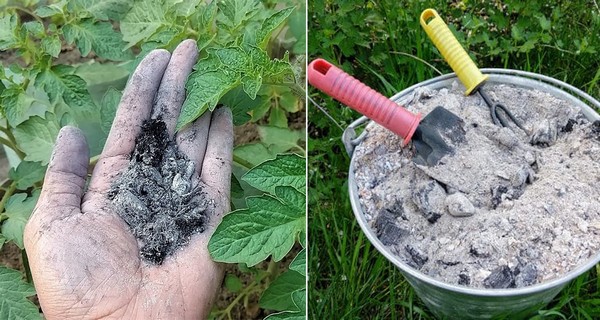Ad Blocker Detected
Our website is made possible by displaying online advertisements to our visitors. Please consider supporting us by disabling your ad blocker.
Why Wood Ash is the Ultimate Garden Fertilizer and Amendment
Are you looking for a natural and effective way to improve your garden’s soil quality? Look no further than wood ash! This often-overlooked resource is a rich source of essential minerals and nutrients that can benefit your lawn, garden, and landscape. In this article, we’ll explore why wood ash is such a valuable resource for gardeners and how you can put it to use in your own backyard.
The Benefits of Wood Ash for Your Garden

One of the primary benefits of wood ash is its high calcium content, which can make up 20% or more of the ash. Calcium is a vital nutrient for plants, helping to ward off diseases like blossom end rot. Additionally, wood ash is a fantastic source of potassium, with a concentration of approximately 5%. Potassium is crucial for healthy plant growth and development, and it’s why wood ash is commonly referred to as “potash.”
But that’s not all – wood ash also contains important minerals like magnesium, sulfur, and phosphorus, as well as trace minerals like manganese, iron, zinc, and copper. These nutrients are all essential for healthy plant growth and development.
Using Wood Ash as an Amendment to Adjust Soil pH
Another significant benefit of wood ash is its ability to adjust soil pH. The high calcium content in wood ash is in the form of calcium carbonate, which is the same substance found in agricultural lime. Adding wood ash to your soil can help raise its pH and reduce acidity, making it more neutral or even slightly alkaline, depending on your goals.
How to Use Wood Ash in Your Garden
Using wood ash in your garden is easy! Simply sprinkle it over your soil and work it in with a garden fork or tiller. Be sure to avoid applying too much, as excessive amounts of wood ash can raise your soil pH too much. As a general rule, apply no more than 1/4 inch of wood ash per year.
You can also use wood ash to fertilize your lawn or as a supplement for potted plants. Just be sure to test your soil’s pH before applying to avoid over-application.
Don’t throw away those wood ashes! With its rich mineral content and pH-adjusting abilities, wood ash is a valuable resource for any gardener. Just remember to use it in moderation and get your soil tested before applying it to ensure optimal results.
1. Amending Lawn and Garden Soil
Wood ash presents an easily accessible source of crucial nutrients such as potassium, calcium, and magnesium that are vital for promoting robust plant growth. Moreover, it’s a popular approach for enhancing your soil’s pH levels.
Nevertheless, it’s crucial to determine when and when not to use wood ash. The key factor to consider is your soil’s pH. By taking advantage of a free soil test, you can determine whether your soil is within the optimal pH range of 6.0 to 7.0, which is suitable for most lawns and garden plants. It’s worth noting that some plants require acidic soil with a lower pH, while others grow better in alkaline soil with a higher pH.
By taking the time to understand your soil’s pH levels, you can make informed decisions regarding the utilization of wood ash and ultimately maximize your plant’s health and growth.
When to Add Wood Ash:
To ensure optimal soil health, it’s important to know when to incorporate wood ash into your gardening routine. If you find that your soil pH is below 6.5, adding wood ash can help address the issue by increasing the availability of magnesium and calcium.
This is particularly important, as a lack of calcium in the soil can lead to issues such as tomato blossom end rot. By incorporating wood ash as needed, you can help promote a thriving, healthy garden.
When NOT to Add Wood Ash:
It’s important to use wood ash in your garden properly to avoid causing harm to your plants. Avoid adding wood ash to soil that is already alkaline, with a pH greater than 7.0, as this can lead to plant damage or even death.
When the soil pH is too high, plants are unable to absorb nutrients effectively, resulting in issues such as yellow leaves in trees and poor growth in some vegetables and fruit trees. Instead, use elemental sulfur to lower the pH in such cases. Additionally, if your soil is already within the optimal range of 6.0 to 7.0, it’s best to leave it be.
Be cautious when applying wood ash around acid-loving plants such as blueberries, rhododendrons, azaleas, and holly, as wood ash can raise the pH and make the soil less suitable for these plants. By following these guidelines, you can use wood ash effectively to promote healthy plant growth.
How to Use Wood Ash in the Garden
If you’re looking to boost your garden’s soil pH, wood ash can be a useful tool. Similar to ground limestone, wood ash can increase soil pH. However, unlike limestone, which can take several months to have an effect, wood ash is water-soluble and can quickly change the soil pH.
When applying wood ash, use roughly double the amount by weight as you would with limestone. By following these guidelines, you can use wood ash to effectively modify your garden’s soil pH and promote healthy plant growth.
For gardeners, it’s important to note that if your soil pH is within the desirable range of 6.0 to 7.0, you can safely apply up to 20 pounds or one 5-gallon pail of hardwood ashes per 1,000 square feet each year without over-acidifying the soil. However, it’s crucial to avoid exceeding this limit, as the excessive application of wood ashes can lead to temporary salt damage. Therefore, exercise caution when using wood ash in your garden.
When working with wood ashes in the garden, it’s important to prioritize safety. Always wear eye protection, gloves, and a dust mask during the application, and be sure to choose a dry, calm day to avoid any wind-borne particles. For best results, broadcast the ashes evenly and mix them into the soil thoroughly before planting.
If any ash settles on actively growing plants, be sure to gently hose it off to prevent foliage burning. By following these tips, you can effectively and safely incorporate wood ash into your garden routine.
More Ways to Use Wood Ash
Discover Additional Applications for Wood Ash: Wood ash, a byproduct of burning wood, has been utilized by our predecessors for over 5,000 years to produce lye, a potent cleaning agent. They discovered that by filtering water through wood ash, they could make lye, which was then combined with animal fats and water to create soap.
The early Americans also relied on ash or homemade lye water to scrub wooden floors, wash clothes and bed linens, and aid in removing hair from freshly killed hogs. For many centuries, potters and ceramicists have used wood ash to produce stunning glazes.
Here are a few more suggestions for modern use:
1. Repel Slugs
Incorporating wood ashes into your gardening routine can provide a natural defense against slugs. Simply sprinkle a small number of ashes around vulnerable plants to create an unpleasant environment for these pests.
The dry texture of the ashes will irritate the slugs’ moist bodies, deterring them from causing damage. It’s worth noting, however, that this method may need to be reapplied after rain or irrigation, as the repellent effect will gradually dissipate once the ashes are dissolved.
Overall, using wood ashes as a slug repellent can be an effective and eco-friendly solution for protecting your plants.
2. Melt Ice and Provide Winter Traction
If you’re looking for an affordable and environmentally friendly solution for melting ice and providing traction during the winter season, wood ashes may just do the trick. By spreading a layer of ashes onto your walks and driveways, you can create a safer environment for yourself and others. While they may not work as effectively as salt, wood ashes are a great alternative as they won’t harm animal paws or damage your paved surfaces.
It’s important to note that ashes can be messy if not applied properly, so taking precautions to prevent tracking them into your home is recommended. Despite this, the benefits of using wood ashes for winter traction and ice melting make them a viable option for any homeowner looking to keep their property safe and accessible.
3. Reduce or Remove Oil Stains
Removing stubborn oil stains from surfaces like asphalt, stone, and cement can be a daunting task, but wood ashes can make the process much easier. Due to their desiccant properties, wood ashes have the ability to absorb liquids from a variety of materials, making them an effective solution for reducing or removing oil stains.
Applying a layer of wood ashes onto the affected area will allow them to absorb any surface liquids. For more difficult stains, simply sprinkle wood ashes onto the stain and use an old rag to scrub the area until the stain is removed. By using wood ashes as a natural cleaning agent, you can eliminate the need for harsh chemicals and achieve a cleaner, safer environment.
4. Clean Glass and Metal
It may come as a surprise, but utilizing hardwood ashes can be an incredibly efficient way to tackle tough stains and grime on various surfaces such as glass, silverware, ovenware, grills, and glass stovetops. Additionally, it can effectively remove stubborn residue left behind by stickers and labels.
To utilize this technique, simply dip a damp cloth into a pile of wood ashes, or create a thick paste by mixing ashes with a small amount of water. Gently scrub the affected area with a cotton cloth and rinse thoroughly with water, using another cloth. It’s important to wear gloves while performing these scrubbing tasks to protect against potential caustic burns.
By using this method, you can achieve a spotless and gleaming finish on your household items with ease. Give it a try and see the impressive results for yourself!


